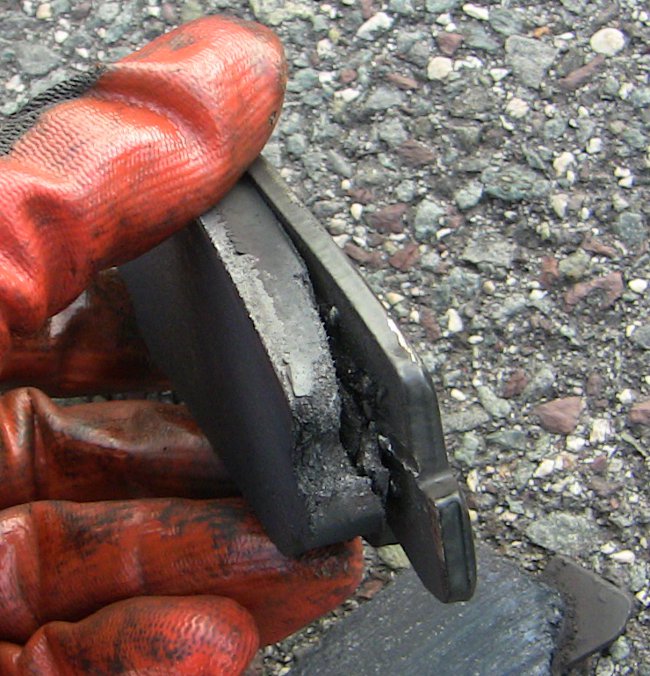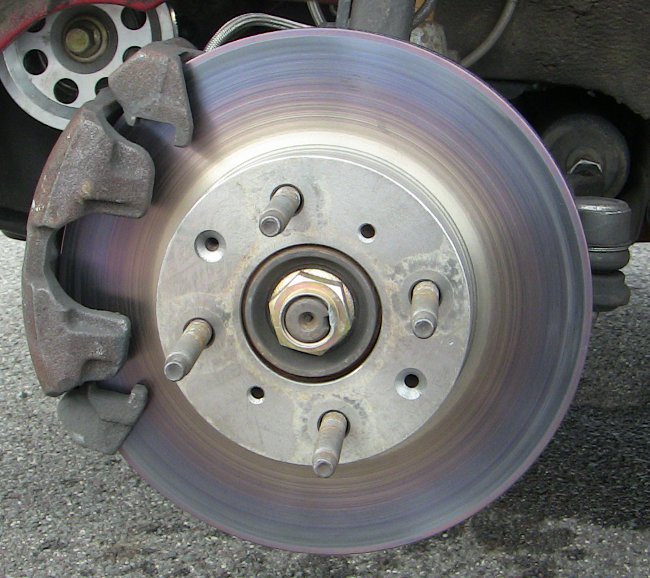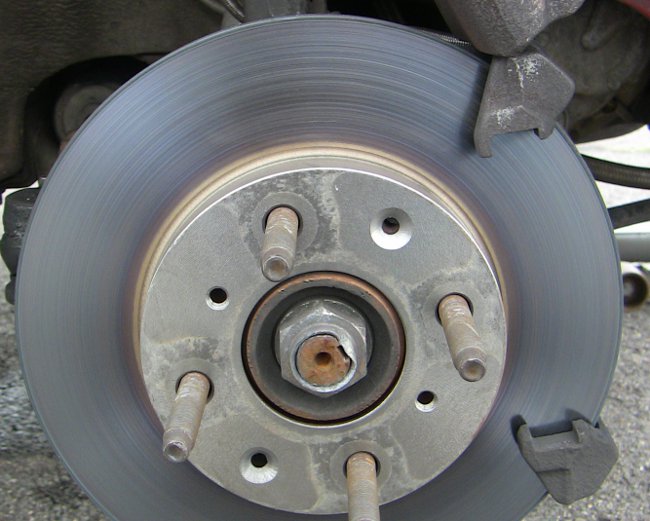Hawk DTC-60 Backing Plate Separation
Published: August 28, 2014
Last weekend at Pocono I experienced backing plate separation from friction material on a brake pad. This took me a while to track down.
Here is how the separated pad looks:

I started the event with brand new Hawk DTC-60 pads and new rotors. I bedded the pads/rotors during the first session by starting with easy driving/braking and generally increasing the braking power through the session.
Emilio of 949racing fame told me to run the car until the pads faded, which is supposed to manifest in a hard pedal and poor stopping power. I did not feel either a hard pedal or a significant reduction in stopping power, so I parked after a couple of hard laps.
Then I took a student out for the second session, and due to additional weight in the car plus there being a student in the right seat I did not push very hard.
While out for the second session, the brake pedal still felt spongy despite new pads and rotors having been installed and presumably bedded. I figured the reason was boiled fluid after running the previous event on Advance Auto Parts brake pads, and elected to bleed the brakes (and replace the master cylinder while at it).
Shortly after the session ended, with the car parked, I heard a pop which often means a brake rotor has cracked. Sure enough, the right front rotor had a big crack through most of the friction surface.
We then replaced the master cylinder and bled the brakes. Due to the way I raised the car we bled the brakes backwards - fronts first and rears last. I hoped this would be OK and went out for a test drive.
On the test drive I had almost no brake pedal. I could press the pedal all the way into the floor until it bottomed out - something I have not been able to achieve in any car I have operated to date. As we replaced old brake parts with new ones, braking performance seemed to be worsening...
Figuring that the backwards bleeding was the problem we raised the entire car and bled it correctly, from the rear right to the front left corner. This time a lot more fluid was coming out of the lines compared to the initial bleeding, and there seemed to be some bubbles in the fluid as well. I was encouraged.
Taking another test drive revealed that the car still had no brakes, and I could just as easily bottom out the pedal while still achieving only modest deceleration. I had to be careful maneuvering in the paddock to not run into parked vehicles, that's how bad the brakes were.
Remembering that Wearever Gold pads cracked and were possibly bending in the backing plates, I decided to take the new pads out and swap in other pads. Unfortunately I seemed to have left Wearever Silvers at home and Golds were known to be bent so putting those on would not have yielded any improvement. Luckily I still had Hawk HP+ pads which just wore to the backing plates in two spots, and I figured these would be acceptable to swap in for a couple of laps to rule out bent pads as a possible problem.
When I removed the Hawk DTC-60 pads from the car I saw one of the right pads - unfortunately I don't remember which one, but I think it was the inside one - separated from the backing plate. With that much empty space in the pad the piston was quite likely running out of stroke before the pad compressed into solid material.
This failure likely occurred during the very first bedding session on the pads. At the most, it happened in 1.5 sessions.
I was surprised that DTC-60 pads - which is a full race pad - separated like that while Wearever street pads did not. I generally have avoided Hawk pads and it looks like I will continue to do so.
The new rotors looked like they have been exposed to some heat:

Note the different color through friction surface. Here is the right side rotor for comparison:

These rotors are the second set of new rotors that I installed after one of the original rotors cracked in the morning.
I don't know if DTC-60 pads ran hotter than Wearever pads, but certainly I would expect DTC-60 to both be designed for and tolerate much higher temperatures than any street pads.
 Visit our
Visit our